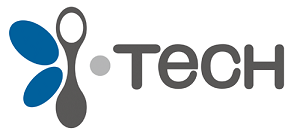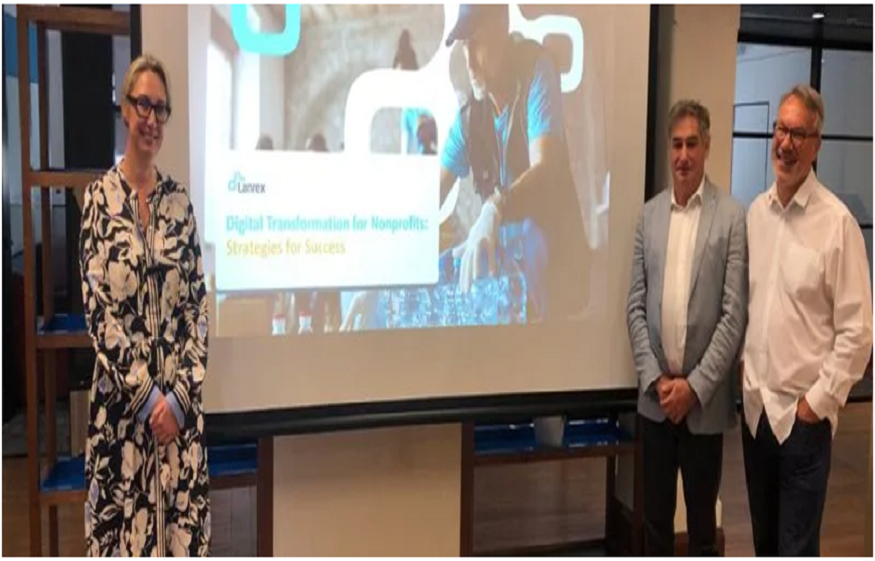At the “Digital Transformation for Nonprofits: Strategies for Success” conference, leaders from the not-for-profit and IT consulting sectors came together to examine how digital advancements can significantly improve the charitable sector’s overall effectiveness.
Co-hosted by Lanrex, Dicker Data, Microsoft, and the Western Sydney Community Legal Centre Limited, the day showcased compelling talks delivered by Jodie Korber, John Hallam, and Phil Meyer. Covering a range of perspectives and viewpoints, participants were presented with the knowledge to help create the actionable plans and practical solutions required to understand and integrate contemporary technology.
In this article, we summarise the six most crucial insights covered during the session.
1. Take a Holistic Approach to Developing Your IT Strategy
Jodie Korber commenced her address by stressing the importance of a robust IT consulting strategy being part of a sustainable digital transformation. She clarified that an effective IT strategy should be woven into an organisation’s core mission and overarching objectives. Should this crucial alignment be absent, not-for-profit entities run the considerable risk of implementing fragmented, or “piecemeal,” IT strategies. While such an approach might appear economically sound at the outset, its eventual outcome invariably involves escalating inefficiencies, increased expenditure, and demoralised teams.
She also underscored the critical significance of engaging all relevant stakeholders during the IT planning phase. Understanding the diverse requirements of various internal teams throughout the organisation is paramount to guaranteeing that the developed strategy underpins both daily operational necessities and broader, long-term goals. Such an integrated perspective then empowers not-for-profit organisations to efficiently expand their activities, while preserving fidelity to their organisational mission.
2. The House Principle in Cyber Security
Jodie Korber introduced the concept of “house principle” as a practical metaphor for understanding cyber security. She clarified that, much like a physical residence, organisations must implement a multi-layered defence approach. This means relying on more than just a single protective measure, acknowledging that no solitary solution offers absolute protection against evolving threats.
Drawing parallels to a home that employs various safeguards—from sturdy locks on doors and windows to sophisticated alarm systems and constant surveillance to deter and detect intruders—a not-for-profit’s information technology infrastructure requires a similar, comprehensive security architecture. This should proactively incorporate preventive measures like mandatory use of strong, unique passwords, coupled with multi-factor authentication (2FA) for all accounts, regular software patching to close vulnerabilities, and comprehensive security awareness training for all staff members.
Equally vital are detection systems, which include advanced cyber monitoring tools designed to identify unusual network activity, suspicious behaviours, and potential threats, alongside continuous log analysis and the integration of real-time threat intelligence. Finally, robust response protocols are crucial, outlining precise, pre-defined steps for containing, eradicating, and recovering from any security incidents.
Furthermore, Jodie underscored the necessity of systematically identifying and meticulously securing critical organisational assets. This extends beyond merely protecting physical equipment and sensitive client data, encompassing intellectual property, user credentials, vital operational systems, and even reputational standing. Understanding which assets are most critical allows an organisation to strategically prioritise security investments and apply the most stringent controls where they are most needed, ensuring resources are allocated effectively.
A truly comprehensive cybersecurity strategy is therefore not a static setup but an evolving, continuous framework. It actively ensures that even in the unfortunate event of a security compromise, the organisation possesses the immediate capability to swiftly identify the breach, contain its spread, and initiate rapid recovery actions. This proactive stance is paramount for minimising potential financial loss, safeguarding invaluable data, preserving reputational integrity, and ultimately ensuring sustained operational continuity.
3. Technology as an Enabler, Not a Cost
John Hallam shared his journey in reshaping the operations of the Western Sydney Community Legal Centre. Upon his arrival, the organisation’s technology landscape was fragmented, characterised by obsolete systems and restricted digital functionality. Instead of perceiving technology merely as an expense, John recognised technology’s vital role in fostering organisational effectiveness and broadening its reach. He understood that strategic technological investment could unlock significant advancements.
He elaborated on how meticulous process mapping, combined with robust data analysis, revealed fundamental shortcomings that were impeding the centre’s capacity to effectively assist its community. This deep dive into their existing workflows allowed for a precise identification of bottlenecks and areas ripe for digital improvement. As a tangible illustration of this approach, call-back rates dramatically improved from 25% to 75%. This significant gain was achieved by strategically resolving key workflow obstructions and leveraging appropriate technology to rationalise and simplify procedures.
This transformative shift empowered the organisation to assist a greater number of individuals without escalating existing expenses. This example showcased how technology can be seen as a powerful instrument for growth and heightened operational effectiveness within the not-for-profit sector.
4. The Power of Data-Driven Narratives
John additionally underscored the role data plays in revolutionising how not-for-profit entities convey their narratives. Through the meticulous collection and analysis of key data, particularly those detailing the unmet requirements within their community, the organisation was able to engage and communicate with funders and key stakeholders with greater impact. This allowed for conversations grounded in verifiable evidence, rather than solely anecdotal accounts, building stronger cases for support.
A compelling example he cited involved presenting data to illustrate how approximately 580,000 residents across Western Sydney could potentially benefit from their services. By presenting the disparity between this immense potential reach and the number of individuals they were presently assisting, they could precisely tailor funding appeals.
Beyond merely refining operational decision-making, this data-driven approach also formed the catalyst for significant internal cultural transformation within the organisation. Teams across departments progressively recognised data as an invaluable strategic asset, shifting away from intuition-based planning. They understood its pivotal role in enhancing accountability, measuring effectiveness and fostering sustainable, long-term impact across all their initiatives, ultimately leading to more targeted and impactful community service delivery.
5. AI as a Productivity Booster
Phil Meyer’s presentation centred on the transformative potential of artificial intelligence (AI) in significantly optimising the operational efficiency of not-for-profit entities. He highlighted how AI isn’t just about automation, but about intelligent assistance that can fundamentally reshape workflows, allowing for smarter resource allocation.
Specifically, he showcased the capabilities of Microsoft 365 Copilot, illustrating its ability to intelligently automate numerous repetitive administrative duties. Examples provided included swiftly summarising lengthy email conversations, automatically compiling comprehensive donor profiles from existing data sources, and efficiently drafting various reports. This substantial reduction in manual administrative workload frees up valuable human capital within the organisation. Consequently, AI empowers staff members to re-allocate their focus towards mission-critical endeavours, such as nurturing vital relationships with donors, engaging with beneficiaries, and innovating service delivery strategies.
Phil proceeded to offer concrete examples illustrating how AI adoption can markedly boost overall productivity, crucially without jeopardising the integrity or security of sensitive data—a paramount concern for a significant number of not-for-profit organisations. By offloading these routine, mundane responsibilities to intelligent automation, organisations are then able to strategically re-direct precious time and resources. This allows for increased investment in initiatives that directly advance the organisation’s core mission and deliver tangible community impact, fostering greater growth and broader service reach.
6. Trustworthy AI Integration
Phil’s discussion further extended to alleviating common concerns surrounding data security and the ethical, responsible deployment of AI within the nonprofit sector. He recognised these as valid considerations for any organisation using advanced digital tools. He emphasised a key distinction: unlike many general-purpose or consumer-grade AI applications, Microsoft 365 Copilot is fundamentally engineered with robust security and stringent compliance protocols built directly into its architecture. This design guarantees that sensitive organisational data, including confidential records and personal details, is protected and strictly private. For not-for-profit entities, which often manage highly personal and sensitive information pertaining to their donors and beneficiaries, such an elevated standard of data protection is not merely beneficial but absolutely crucial for maintaining trust and fulfilling regulatory obligations.
Phil strongly advocated for nonprofits to welcome AI not as a substitute for valuable human contributions, but rather as a powerful auxiliary tool designed to amplify and augment human capabilities. His message was clear: AI is about augmentation, not displacement. As an illustration, AI can liberate staff members from time-consuming, lower-value activities, enabling them to concentrate on high-impact strategic initiatives. Simultaneously, AI provides sophisticated insights and generates operational efficiencies that were previously unattainable through manual processes, fundamentally enhancing an organisation’s overall effectiveness and reach.
Contact Lanrex
The main takeaway participants went away with was the profound capacity of technology to empower not-for-profit organisations. When adopted with careful strategic foresight, technology becomes a pivotal enabler, allowing these entities to pursue and achieve their vital missions with significantly greater impact and efficiency in the communities they serve
The diverse presentations collectively provided a wealth of practical, actionable insights and strategies. These insights spanned a spectrum of critical areas, from formulating resilient IT strategies and intelligently harnessing data for compelling advocacy and storytelling, right through to the responsible integration of advanced AI tools designed to elevate operational productivity.
Such comprehensive guidance proved invaluable for not-for-profit organisations, regardless of their current position on the digital transformation roadmap, helping them navigate complex technological landscapes with greater confidence and purpose.
To find out more, contact Lanrex today!

